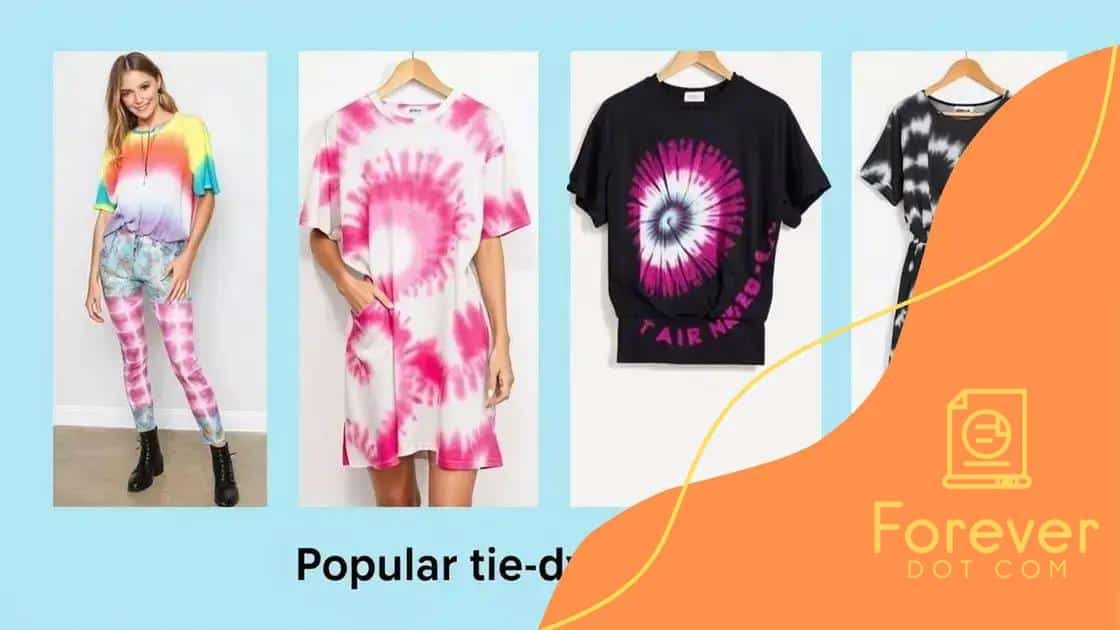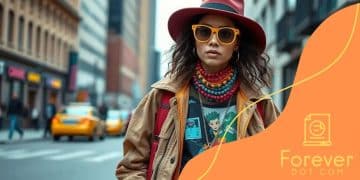The resurgence of tie-dye in fashion: a vibrant trend

The resurgence of tie-dye in fashion combines vibrant, unique styles with sustainable practices, offering a creative way for individuals to express themselves while considering environmental impact.
The resurgence of tie-dye in fashion is not just a fleeting trend; it’s a revival of vibrant self-expression. Have you noticed how this style has made its way back into your closet? Let’s dive into its colorful journey.
The origins of tie-dye culture
The story of tie-dye begins centuries ago. This vibrant technique has roots in various cultures around the world, each adding its own flavor to this colorful art form. In Asia, for instance, the Japanese shibori method is one of the oldest tie-dye techniques, with records dating back to the 8th century.
In the 1960s, tie-dye saw a significant revival, especially in the United States. It became a symbol of the counterculture movement, expressing individuality and rebellion. The psychedelic colors and unique patterns attracted many who wished to embrace free spirit and creativity.
Different cultures and their techniques
Various cultures across the globe contributed to the evolution of tie-dye.
- India: Known for using vibrant colors, Indian tie-dye techniques like bandhani have been practiced for centuries.
- Africa: African artisans often employ a method called ikat, which involves dyeing yarn before weaving.
- Indonesia: The Batik technique uses wax to create intricate patterns, showcasing the cultural heritage of the region.
As these diverse techniques spread, they blended into various fashion trends, influencing designers around the world. Today, tie-dye is celebrated not only for its artistic value but also for its connection to social movements and cultural expression.
In modern times, the resurgence of tie-dye in fashion reflects a desire for personalization and uniqueness. Many people appreciate the handmade nature of tie-dye, as each piece is distinct, showcasing the beauty of imperfection.
How tie-dye made a comeback
The comeback of tie-dye in recent years is nothing short of remarkable. Once considered a relic of the 1960s and 1970s, this craft has captivated a new generation. Many people today are seeking ways to express their individuality, and tie-dye provides a vibrant, colorful medium to do just that.
Social media has played a vital role in this resurgence. Platforms like Instagram and TikTok have allowed users to share DIY tie-dye projects, showcasing unique designs and inspiring creativity. The hashtag #tiedye has garnered millions of posts, making it a trend that is hard to miss.
Popular styles in the modern era
Today’s tie-dye ranges from classic patterns to innovative designs. As styles evolve, so do techniques, blending traditional methods with contemporary flair.
- Psychedelic designs: Bright colors and intricate patterns evoke a sense of nostalgia while appealing to the modern aesthetic.
- Pastel hues: Softer colors have emerged, providing a more subtle option for those looking to incorporate tie-dye into everyday wear.
- DIY kits: The rise of craft kits facilitates the do-it-yourself movement, making it accessible for beginners.
Fashion designers are also embracing this trend, incorporating tie-dye into their collections. High-end brands showcase tie-dye in chic, elevated ways, proving that this style transcends casual wear.
The eco-conscious movement has also influenced the tie-dye resurgence. Many brands use sustainable materials and dyes, appealing to those who prioritize environmental responsibility. As a result, tie-dye represents not only a fashion statement but also a commitment to a more sustainable future.
Popular styles and trends in tie-dye

Tie-dye has evolved into a vibrant fashion statement with a variety of popular styles surfacing today. From classic designs to trendier twists, the choices are abundant and cater to all tastes. This versatility makes tie-dye appealing to many, allowing individuals to express their identity through clothing.
Modern tie-dye incorporates different techniques and color palettes that make each piece unique. Whether you prefer bold and bright or soft pastels, there’s a tie-dye style for everyone.
Current trends in tie-dye
Several key trends are shaping the world of tie-dye right now:
- Ombre effects: Gradients of color that blend seamlessly make for a stunning visual appeal.
- Reverse tie-dye: Instead of adding color, this technique removes dye, creating a contrasting look on darker fabrics.
- Minimalist designs: Simple streaks or dots offer a modern twist on traditional tie-dye for those who prefer subtlety.
The resurgence of tie-dye in both casual and formal wear illustrates its adaptability. Designers are now incorporating tie-dye into high-fashion collections, showcasing it on runways and red carpets alike.
Retro aesthetics combine with modern flair, merging nostalgic vibes with fresh twists. Tie-dye is seen in various clothing items, from dresses and swimsuits to accessories like bags and hats. This blend of styles makes tie-dye an exciting choice for anyone looking to enhance their wardrobe.
Tips for styling tie-dye outfits
Styling tie-dye outfits can be a fun and creative way to express your personality. With the right combinations, you can make a vibrant statement or keep it subtle. Here are some tips to help you master the art of wearing tie-dye.
Start by choosing the right colors. Vibrant hues work well for casual settings, while softer tones can be great for more formal occasions. Remember that tie-dye is about playfulness, so don’t be afraid to mix different patterns.
Accessorizing your tie-dye
The accessories you choose can enhance your tie-dye ensemble significantly:
- Footwear: Sneakers or sandals in neutral colors help balance bold tie-dye.
- Jewelry: Simple, minimalistic pieces can add elegance without overwhelming the outfit.
- Bags: A solid color bag complements the vibrant patterns of tie-dye, making it an ideal choice.
Layering is another effective way to style tie-dye. A denim jacket or a solid cardigan can tone down the brightness while adding dimension to your look. Experimenting with different layers can completely change how your tie-dye appears.
Additionally, consider pairing tie-dye with solid colors. This combination creates a visual break and allows the tie-dye to stand out. For instance, wearing a tie-dye shirt with plain jeans can keep the focus on your stylish top.
Sustainable practices in tie-dye fashion
As the fashion industry evolves, sustainability plays a crucial role in shaping how we create and wear clothes. Tie-dye fashion is no exception to this trend, as it embraces eco-friendly practices that appeal to environmentally conscious consumers. Many brands are now focusing on sustainable materials and methods.
One significant aspect of sustainable tie-dye is the use of organic fabrics. Materials such as organic cotton or hemp are not only better for the environment but also provide a soft, comfortable feel. These fabrics reduce the impact of harmful chemicals and pesticides on the planet.
Eco-friendly dyeing techniques
Another vital practice is the choice of dyes. Traditional dyeing processes often involve chemicals that can be harmful. However, many artisans and brands are shifting to:
- Natural dyes: Extracted from plants, fruits, and minerals, these dyes are biodegradable and less harsh on the environment.
- Low-impact dyes: These dyes require less water and energy, making them more sustainable.
- Recycled dyes: Some brands use dyes made from waste materials, reducing overall waste.
Additionally, tie-dye can often be done at home, promoting a DIY approach that encourages creativity while minimizing commercial production. People can repurpose old clothes by adding a splash of color and giving them a new life through tie-dye.
Lasting change in the fashion industry involves both consumers and producers. By supporting sustainable tie-dye brands, consumers can help promote practices that respect the earth while enjoying bold, unique styles.
FAQ – Frequently Asked Questions about Tie-Dye Fashion
What are the benefits of using sustainable materials in tie-dye?
Using sustainable materials reduces environmental impact and promotes eco-friendly practices in the fashion industry.
How can I create tie-dye designs at home?
You can create tie-dye at home using basic supplies like white clothing, fabric dye, rubber bands, and a workspace. There are numerous online tutorials to guide you.
What are some popular tie-dye techniques?
Popular techniques include traditional spiral designs, the ombre effect, and reverse tie-dye, where color is removed from darker fabrics.
How can I style my tie-dye outfits?
For styling, pair tie-dye with solid color pieces, use neutral accessories, and consider layering with jackets or cardigans to balance the look.






